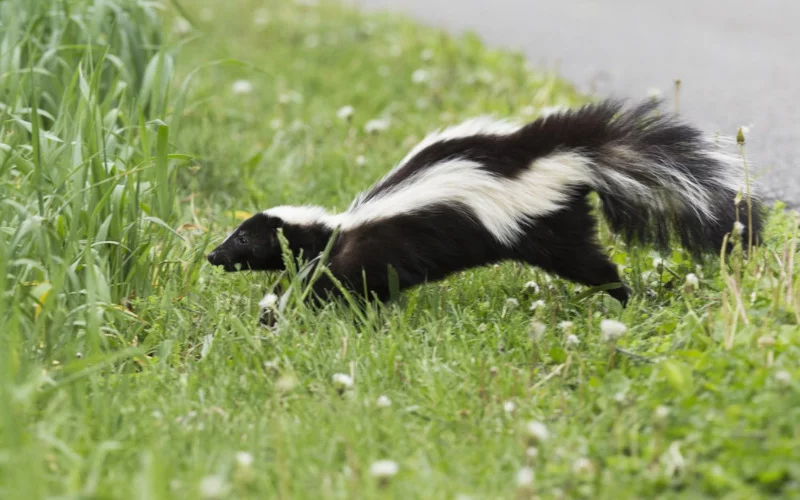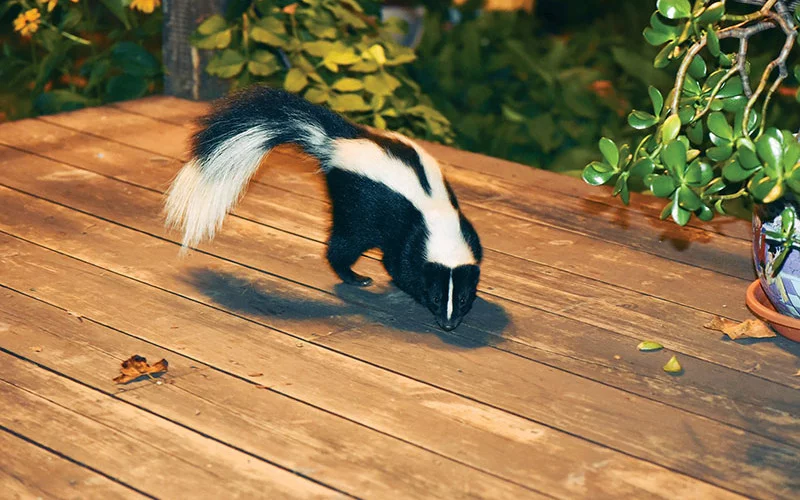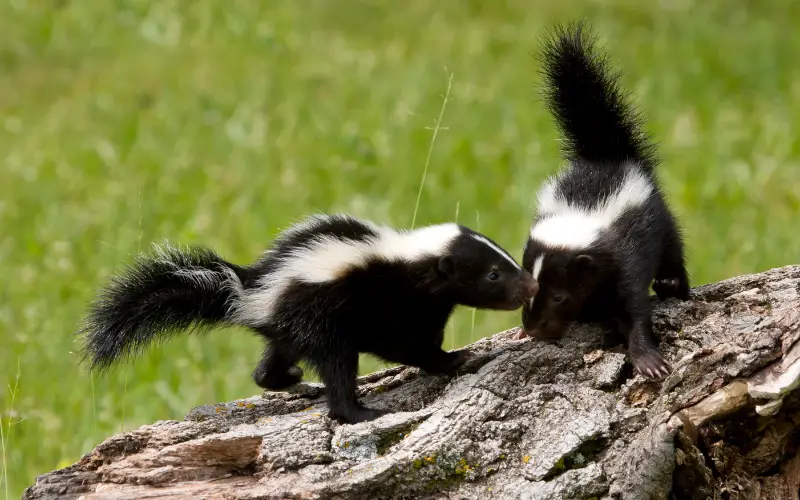Skunks are animals of mystery and intrigue. Being a slightly misunderstood animal, we often wonder if there are more to skunks.
Their behaviors, facts, diet, etymology, and reproduction. We are also curious about their physical abilities. Can they climb? Can they jump? Or can they do both? If they can, how far can they go?
Satiating our need for more knowledge on these creatures, researchers have made several interesting discoveries.
Can Skunks Climb?
Yes, skunks can climb. They possess short and well-muscled legs with sharp claws, which serve as a huge help when climbing and digging.
While skunks can climb, they are not exactly great at it. Meaning that there is a limit to how high a skunk can climb.
Studies show that the spotted skunk species are better climbers than the striped skunk. They have enhanced claws that help them climb.
How High Can Skunks Climb?

Most skunks (striped skunks) are known to climb as high as 6 feet. As mentioned earlier, skunks possess claws that help climbing, but their claws are best suited for digging.
Very few skunks (spotted skunks) can exceed the 6 feet limit. The spotted skunks possess modified claws that allow them to climb on distance like trees, infiltrating chimneys and attics, high fences.
Striped skunks have been given the title of not being very good at climbing.
Skunks and Their Behavior
Skunks belong to the family Mephitidae (the weasel family). Different skunks vary in color and size; an average Skunk is said to be 16 to 37 inches long (40.64cm to 93.98cm), their tail included, they have an elongated body.
These animals can be found in settled areas like the United States, Northern Mexico, Southern and Central Canada and south suburb regions.
They are partial hibernators during the winter period; they live in holes and burrows made by other animals or themselves. Skunks are nocturnal; that is, they are more active at night.
Despite having a great sense of smell and hearing, they have poor vision, leaving them in accidents.
They are omnivores eating both plants and animals; they sometimes feed on leftovers and garbage.
Skunks are immune to the venom of snakes, so they sometimes feed on poisonous snakes like a rattlesnake.
They are also scavengers feeding off the remains of rodents and birds. Being one of the major predators of bees, wasp, and hornets (yellow jacket), they often feed on their hives.
While the striped skunk is the well-known species of skunk, there are also other species of skunks varying in physical appearance, like the hooded skunk, the spotted skunk, and others.
Skunks are also known for their anal spray, which emits a foul odor into the atmosphere. A skunk spray can range up to 10 feet and can be perceived 1.5 miles from its initial position.
The skunk spray consists of Sulphur containing chemicals, which have proven to be highly flammable.
A skunk anal spray is used as a defense mechanism to ward off predators and other external threats.
Skunks are friendly towards humans and rarely bites, they only spray when they feel threatened, and skunks give a little warning before spraying.
They stomp their foot and make hissing sounds; they also fake death with the anal region aimed at the threat. The striped skunk has been recognized as the most social skunk.
Can Skunks Jump Like a Cat?
A cat can jump as high as 8 feet, whereas a skunk can jump as high as 3 feet. Climbing and jumping is not a skunk specialty.
A normal cat can jump as high as 6 to 8 feet, while an ill cat can jump 3 feet. Giving cats the upper hand.
Can Skunks Climb Stairs?
A step on a stair is approximately 7.5 inches long. 7.5 inches is not considered very high; hence it will be very easy for a skunk to climb stairs.
How Can Skunks Affect Your Property?

Skunks use their sharp claws to dig tunnels under buildings and fences, increasing the risk of structural failure.
They also chew through wood and other materials causing temporary or permanent damage.
Skunks anal spray is obnoxious and extremely difficult to get rid of, leaving a lingering smell on personal possessions like clothing.
A mixture of hydrogen peroxide, baking soda and dishwashing soap can be used to get rid of the smell on dogs.
Skunks, one of the primary carriers of bacteria and pathogens, including rabies, can bite and infect humans and livestock.
The Best Fence to Keep Skunks Out
When selecting a skunk proof fence, the height of this fence should be considered, and the material being used to make the fence.
Skunks being able to climb as high as 6 feet and jump as high as 3 feet, a skunk proof fence should be at least 8 feet tall.
The height of the fence will pose a problem for the skunks. Even with a fence as tall as 8 feet, skunks can still infiltrate by their remarkable digging ability.
Redwood, Cypress and Cedarwood are better alternatives to timber when it comes to fencing. Metal, brick, and block fences should be considered as skunks cannot dig or chew through these materials.
How to Keep Skunks Away from Your House
As ironic as it may seem, Skunks detest the smell of citrus, ammonia, and peppermint. These substances can be used to keep skunks away when soaked in a rag cloth.
Maintaining a clean environment is advisable as skunks are attracted to garbage and leftovers. Trash should be taken out daily.
Skunks carry out most of their activities during the night as they are nocturnal. A flood of light at night might prevent skunks from infiltrating the premises.
Skunks are very interesting creatures despite the nuisance they cause. Further studies of skunks might suggest more ways to use skunks for ecological development and growth.
You May Also Like:
- How High Can a Raccoon Jump
- Can You Eat Squirrel From Your Backyard
- What Sorts of Food Does Backyard Lizard Eat?
Hope this article helped you know if Skunks Climb or Jump. You may also want to find out If a Squirrel is Safe to Be Eaten.
I will love to hear from you if you have any other suggestions on Skunks ability to Climb or Jump. All you have to do is comment below and reach out to people by sharing this post on social media.
If you liked this article, then please follow us on Facebook, Instagram and Pinterest.

